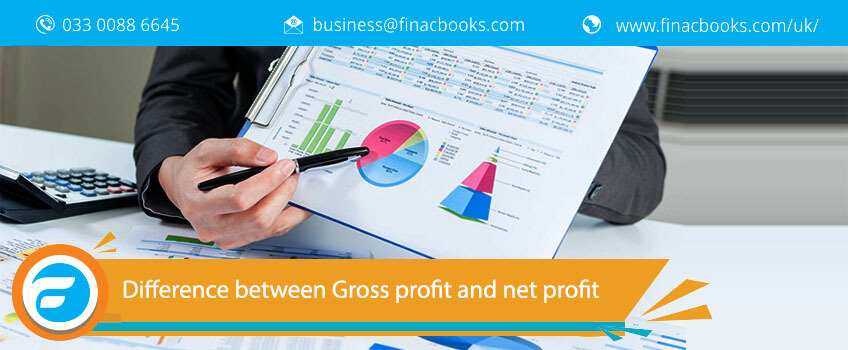Gross Profits
Gross profit means revenue minus the cost of goods sold. Gross profit is the revenue derived from sale or service after deducting the direct cost associated with buying, manufacturing, selling or shipping the product to the customer. Certain fixed costs & rent is always excluded from the revenue.
Gross profit formula - Revenue - COGS (Cost of goods sold)
For example – If you sold an item for £10 and it actually costs you £6. Then, the Gross profit will be £10-£6 = £4. In this example – we deduct the revenue (£10) from the cost of goods sold (£6) and calculate the gross profit (£4).
Therefore, Gross profit is basically a difference between the revenue generated by a product or service and the cost of producing it. Gross profit doesn’t account for other costs that are deducted to give net profit. For example – Taxation, interest, payroll, other overheads etc. By not considering all these costs, it does not show you the true profit of your business. It only helps you in showing that how much growth your business has done in a particular period.

What is the cost of goods sold?
The cost of goods sold is the money spent on the production of your product. Additionally, this is referred to as the direct cost of sales. It includes -
- Cost of raw materials
- The expense of transporting raw materials to your location.
- Costs of labour
- Production costs, for example, the utilities used to power the equipment utilised to manufacture the product.
In simple terms, gross profit indicates the amount of value generated by the sale of a product or service.
Having said that, this is merely a snapshot. Gross profit excludes operational expenses (which are subtracted to determine operating profit), tax, wages, and interest. As a result, your gross profit margin may imply that you are a multimillionaire, but your net profit margin may tell a different story.
Net Profits
Net profit means Gross profit minus all indirect expenses. Net profit is the revenue derived from selling a product or service after deducting all expenses, including COGS. To calculate net profit, you have to deduct each cost you incurred for running a business in a particular year. It includes costs such as utility bills, rent, marketing cost, distribution cost, salaries, car cost etc.
When you deduct all expenses from your total income, you will easily get the net profit.
Net Profit formula = Sales - (Cost of Goods Sold + Allowable Expenses)
Net profit formula = Gross profit - all indirect expenses
For example – Suppose your total income is £60,000 and the cost of running a business is £30,000. Net profit =?
Net profit = Total income – Total business expenses or cost of running a business = £60,000 - £30,000 = £30,000
In net Profit, all expenses include general, selling & administrative as well as non-operating expenses. The list of expenses deducted to calculate net profit are given below –
- Rent
- Utility bills
- Insurance
- Salary paid to employees
- Stationery
- Property tax
- Fees paid to professionals
- Depreciation etc.
The account prepared to calculate net profit or net loss is known as the Profit & loss account. To understand the difference between Gross profit & Net profit more clearly, see the table below –
Gross profit vs Net profit
What is an income statement?
An income statement is a financial statement that summarises a business's revenue and expenses. It is used in connection with a balance sheet and cash flow statement to help firms determine and understand their company's financial health.
The following information will be included in an company's income statement:
- Revenue
- Cost of goods sold (COGS)
- Expenses and expenditures associated with advertising, administration, and operations.
- Gross profit
- Gains — Proceeds from activities other than the primary operation of a business, such as the sale of an investment.
- Costs of interest/finance
- Depreciation - An expected expense used to reduce an asset's carrying value, such as manufacturing equipment that would depreciate over time.
- Earnings before tax (EBT)
- Net Profit
Profit Margins
To access their performance, many businesses used profit margin calculations. It is also used as a key performance indicator to set targets. There are two different profit margins –
Gross profit margin
Gross profit margin is calculated by dividing the company's gross profit by revenue. For example – ABC Ltd. Company has revenue of £200,000 with the cost of sales given is £120,000. Calculate gross profit margin?
Revenue (given) = £200,000 Cost of sales (given) = £120,000 Gross profit margin = Gross profit / Revenue, Gross profit = Sales – COGS = £200,000 - £120,000 = £80,000, Gross profit margin = £80,000/£200,000 = 0.40 or 40%.
Net Profit margin
Net profit margin is calculated by dividing net profit by revenue. It is a more accurate measure of company's profitability as it shows true profit of your business. For ex – ABC Ltd. has a Gross profit of £200,000 with total expenses given is £120,000 & revenue is 300,000. Calculate the Net profit margin? G.P (given) = £200,000 Total expenses = £120,000 Revenue = £300,000 Net profit margin = Net profit / Revenue Net Profit = Gross profit – total expenses = £200,000– £120,000= £80,000 Net profit = £80,000/£300,000 = 26.6%.
| Basis of Distinction | Gross Profit | Net Profit |
| Meaning | Gross profit means Revenue minus Cost of Goods sold | Net profit means Gross profit minus all indirect expenses |
| True Profit | It doesn’t show the true profit of the business | It shows the true profit of the business. |
| Account prepared | Trading account is prepared to calculate the Gross profit | Profit & loss account is prepared to calculate the Net profit |
| Balance | It shows the credit balance of the trading account | It shows the Credit balance of the Profit & loss account |
| Judgement | The growth of the business can be judged by comparing G.P with net sales | The profitability of the business can be measured by comparing the net profit with net sales. |
Why do you need both Net Profit & Gross Profit Calculation?
Calculating gross profit & net profit is very necessary for the business. Gross profit may not show you the real profit of your business, but it should be calculated to know how much growth your business is doing. Gross income provides you information on how much revenue you earned from a product or service after deducting all direct costs from it. It also helps you in planning how you can take your business forward. Sometimes, your gross profit may increase, but your net profit goes on decreasing, and you feel that this situation will impact your business badly, but it is not necessary that it will impact. When your sales start rising, and in future, you reach the level, where you need to shift to the large quarters, it will incur a high cost. Moving into large quarters will entail high rent and also other costs associated with it. As a result, you will see that there is a slight dip in the net profit. In that case, the gross profit figure will tell you how much growth your business is doing, and it will reflect in increased sales. After some time, the moving cost which you have already paid will stop putting down your net profit. Higher rent on new quarters will remain the same, but an increase in production will increase the gross profit and finally result in the rise of net profit again. Net profit tells you the real story. If your sales are increasing slowly, but fixed costs are increasing more rapidly, it will result in a drop in net profits. It can be resolved if you will increase your sales at a faster rate by doing something.
Limitations of gross and net profit
While gross and net profit are both useful profitability indicators, they do have limitations. For instance, gross profit does not account for all of your business's expenses and is not necessarily an accurate reflection of your company's profits. Additionally, as previously stated, it is difficult to benchmark gross profit because it varies by industry. For example, service-based organisations are likely to have better margins than industries such as manufacturing or construction, which often generate tangible goods and must purchase raw materials to do so.
While net profit is a more comprehensive indicator of a business's profitability, it does have some drawbacks. One-time transactions, such as the selling of property, can be impacted, which might temporarily enhance net income. The key point again is that profit is clearly distinct from actual cash in the bank.
How Finacbooks help?
FinacBooks is a leading platform where you can search for qualified accountants offering a range of services like tax Bookkeeping, Tax Return filing, VAT registration, Payroll registrations and RTI returns, Pensions and auto-enrolment, Tax investigation service, Business planning, management of accounts and more. We have better options with us where you can use automated HMRC compatible software for filing VAT returns which help you make MTD compliant and saves you from incurring fines and penalties.
Any Questions? Request a callback from our Tax Experts.


































